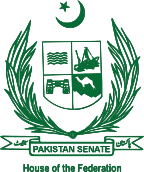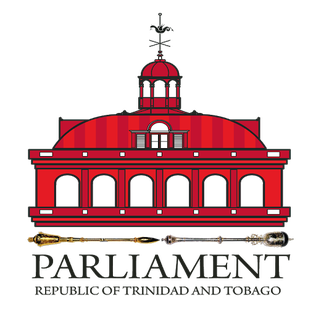Related Research Articles

The Senate of Pakistan or Aiwān-e-Bālā Pākistān, constitutionally House of the Federation is the upper legislative chamber of the bicameral parliament of Pakistan. As of 2023, It has a total of 100 seats, of which 92 are elected by the provincial legislatures of Pakistan, with equal representation of 23 seats for all provinces, using indirect single transferable votes, while 4 represent the Federal Capital and the remaining 4 are representing FATA, until membership expiration in 2024. Elections are held every three years for one half of the house, each Senator has a term of six years. Unlike the National Assembly, the Senate is a continuing chamber and hence not subject to dissolution.

The Parliament of Trinidad and Tobago is the legislative branch of the Government of Trinidad and Tobago. The Parliament is bicameral. Besides the President of Trinidad and Tobago, it is composed of the House of Representatives, which is composed of the Speaker of the House of Representatives in addition to 41 directly elected members serving a five-year term in single-seat constituencies, and the Senate which has 31 members appointed by the President: 16 Government Senators appointed on the advice of the Prime Minister, 6 Opposition Senators appointed on the advice of the Leader of the Opposition and 9 Independent Senators appointed by the President to represent other sectors of civil society. It is at present the only parliament in the world with an incumbent female President, President of the Senate, Speaker of the House of Representatives and Leader of the Opposition and made history by appointing the Caribbean's first and only transgender parliamentarian on 15 February 2022. As of 20 April 2021, there are only 24 female members, or 32.9% and eight members born in Tobago or 11.0%.
Pierrette Ringuette, also formerly known as Pierrette Ringuette-Maltais, is a Canadian Senator.

Nancy Hodges was a Canadian journalist and politician. Over her career, she served as a Member of the Legislative Assembly of British Columbia, as the Speaker of the Legislative Assembly of British Columbia, and as a member of the Senate of Canada. She was the first woman in the Commonwealth of Nations to become Speaker, and was known as a powerful women's rights activist in the Commonwealth.
There have been 153 women in the Australian House of Representatives since the establishment of the Parliament of Australia. Women have had the right to both vote and sit in parliament since 1902. The first woman to run for the House of Representatives was Selina Anderson at the 1903 election for Dalley, but the first woman elected to the House was Dame Enid Lyons at the 1943 election for Darwin. At that election, the first woman member of the Senate was also elected, and there have been women members of the Senate continuously ever since. By contrast, the House of Representatives has had women members continuously only since 1980.
There have been 121 women in the Australian Senate since the establishment of the Parliament of Australia. Women have had the right to stand for federal parliament since 1902, and there were three female candidates for the Senate at the 1903 federal election. However, it was not until Dorothy Tangney's victory at the 1943 federal election that a woman was elected. Since then, all states and territories have had multiple female senators – in chronological order: Western Australia (1943), Queensland (1947), Victoria (1950), South Australia (1955), Tasmania (1975), the Australian Capital Territory (1975), New South Wales (1987), and the Northern Territory (1998).

Dame Annabelle Jane Mary Rankin DBE was an Australian politician and diplomat. She was the first woman from Queensland elected to parliament, the first woman federal departmental minister, and the first Australian woman to be appointed head of a foreign mission.
Government in Australia is elected by universal suffrage and Australian women participate in all levels of the government of the nation. In 1902, the newly formed Commonwealth of Australia became the first nation on earth to enact equal suffrage, enabling women to both vote and stand for election alongside men Women have been represented in Australian state parliaments since 1921, and in the Federal Parliament since 1943. The first female leader of an Australian State or Territory was elected in 1989, and the first female Prime Minister took office in 2010. In 2019 for the first time, a majority of members of the Australian Senate were women. At the time of its foundation in 1901, and again since 1952, Australia has had a female monarch as ceremonial Head of State, while the first female Governor of an Australian State was appointed in 1991, and the first female Governor-General of Australia took office in 2008.
Gender representation has been a significant issue in Canadian politics.
Upon the dissolution of the 39th Canadian Parliament, 65 of the 308 seats were held by women. Canada ranks 45th in the world in representation of women in the national lower house.
Widow's succession was a political practice prominent in some countries in the early part of the 20th century, by which a politician who died in office was directly succeeded by their widow, either through election or direct appointment to the seat. Many of the earliest women to hold political office in the modern era attained their positions through this practice. It also occurred when politicians stood down from a particular office.
Women were first allowed to vote at the federal level in Canada in the 1917 general election in connection with military service, and were allowed to vote under the same conditions as men beginning on May 24, 1918. The next four elections saw only one woman elected: Agnes Macphail. The 1936 election saw two women in the House together for the first time. A by-election in 1941 saw a woman elected to the governing caucus for the first time. The 22nd federal election in 1953 was a slight breakthrough, electing four women, which was 1.5% of the House. Every Parliament thenafter would have at least two women at a time, except for the 28th Parliament from 1968 to 1972, in which Grace MacInnis was the only woman. Then 30th Parliament, elected in 1974, was another breakthrough, containing nine women MPs following the general election and rising to ten due to a by-election in 1976. The number of women in the House would not fall below ten again.
During the 15th Canadian Parliament, there was no change in representation by women. Four women ran for seats in the Canadian House of Commons in the 1925 federal election but Agnes Macphail, first elected in 1921, continued to be the only woman elected.
During the 16th Canadian Parliament, women sat as members for the first time in both the House of Commons and the Senate. Two women ran for seats in the Canadian House of Commons in the 1926 federal election but Agnes Macphail, first elected in 1921, continued to be the only woman elected.
During the 18th Canadian Parliament, two women sat in the House of Commons for the first time. Sixteen women ran for seats in the Canadian House of Commons in the 1935 federal election. Agnes Macphail, first elected in 1921, was reelected in the newly created riding of Grey—Bruce. Martha Black, running in the place of her sick husband George Black as an independent Conservative, was elected for the Yukon riding, becoming the second woman to be elected to the House of Commons. Cairine Wilson and Iva Campbell Fallis continued to sit as members of the Senate.
During the 19th Canadian Parliament, for the first time, a woman sat as a member of the party holding the majority in the House of Commons. Nine women ran for seats in the Canadian House of Commons in the 1940 federal election. Dorise Nielsen was elected in the North Battleford riding as a Unity member; she was the third woman and the first Communist to sit in the House of Commons. Agnes Macphail, first elected in 1921, was defeated. Martha Black chose to step aside to allow her husband George Black to run for reelection. Cairine Wilson and Iva Campbell Fallis continued to sit as members of the Senate.
During the 20th Canadian Parliament, women continued to sit as members of both the House of Commons and the Senate. Nineteen women ran for seats in the Canadian House of Commons in the 1945 federal election. Gladys Strum was elected in the Qu'Appelle riding as a Co-operative Commonwealth Federation member; she was the fourth woman to sit in the House of Commons and the first woman to serve as president of a Canadian political party. Cairine Wilson and Iva Campbell Fallis continued to sit as members of the Senate.
During the 21st Canadian Parliament, the number of sitting women senators increased. Eleven women ran for seats in the Canadian House of Commons in the 1949 federal election; none were elected. However, Ellen Fairclough, who had run unsuccessfully in the Hamilton West riding as a Progressive Conservative, was elected in a May 1950 by-election held after the incumbent was appointed to the Ontario Supreme Court.
The number of women sitting in the House of Commons increased to six during the 26th Canadian Parliament; the number of women senators remained at six. 40 women ran for seats in the Canadian House of Commons in the 1963 federal election; two women out of five incumbents were reelected. Ellen Fairclough, Isabel Hardie and Margaret Mary Macdonald were defeated when they ran for reelection. Pauline Jewett and Margaret Konantz were elected to the House of Commons in the general election; Eloise Jones and Margaret Rideout were elected in by-elections held in June 1964.
The number of women sitting in the House of Commons decreased to four during the 27th Canadian Parliament; the number of women senators returned to six. 37 women ran for seats in the Canadian House of Commons in the 1965 federal election; three women out of six incumbents were reelected. Pauline Jewett and Margaret Konantz were defeated when they ran for reelection; Eloise Jones did not run for reelection. Grace MacInnis was also elected to the House of Commons in the general election, becoming the first woman elected to the House of Commons from British Columbia.
References
- ↑ Basen, Ira; Farrow, Jane (2017). The Book of Lists: Revised and Updated and Even More Canadian. p. 15. ISBN 978-0735273078.
- ↑ Parliament of Canada: Women Candidates in General Elections